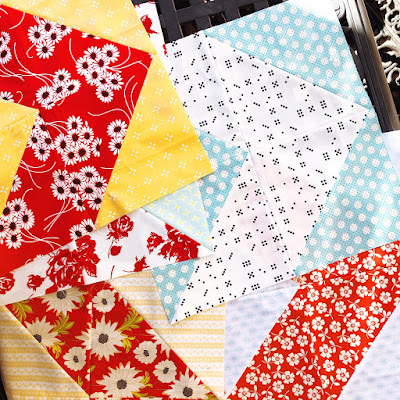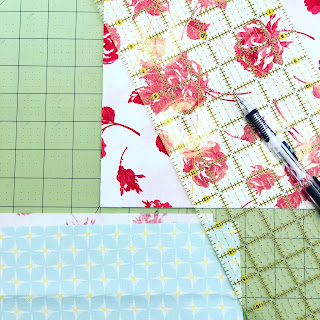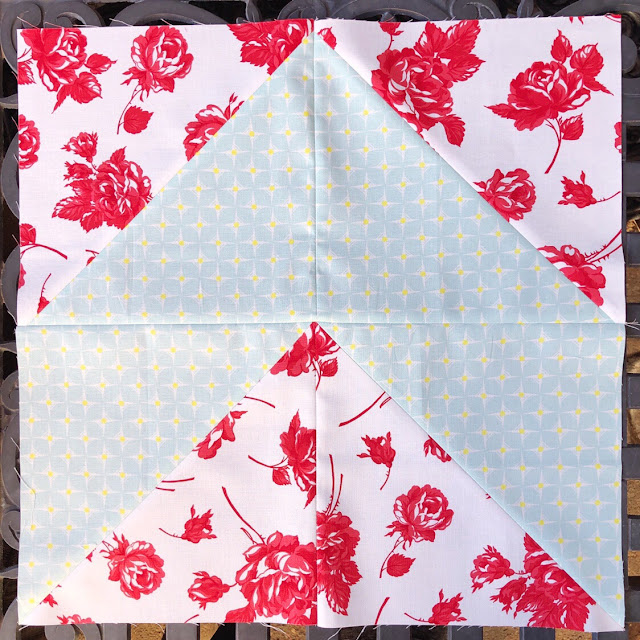chevrons are so, i don't know, five years ago, right? but they are kind of classic, too. especially in a formation where they aren't creating a solid zig-zag pattern across the quilt.
they are also an incredibly easy block make. this quilt top (that i finally got around to completing after making the first 2 blocks about 4 years ago) went really, really fast.
if you are an experienced quilter, here's the quick explanation of how to make a 16" chevron block:
1. cut 2 - 9" squares of each of 2 fabrics in your block (4 total)
2. make 4 hsts from the blocks and trim to 8.5"
3. arrange the hsts in a chevron formation and join together
it's so easy.
the above quilt top, which measures 64" x 80", is composed of 20 chevron blocks in a 4 column by 5 row grid.
fabric requirements:
20 fat or skinny quarters (makes two of each block, 10 different styles total)
or
40 fat or skinny quarters (makes one of each block, 20 unique blocks)
or
2 - 9" sqs each of 40 fabrics (makes one of each block, 20 unique blocks)
or
2 layer cakes (makes one of each block, 20 unique blocks. layer cakes are 10" squares, so you will either make larger blocks or trim each piece down to 9" to start.)
as i was making a set of blocks, i decided to photograph the process with my phone. the pictures are not pretty or of high, professional quality but if you need more detailed instructions and photos to guide you along the way, here you are:
cut 2 - 9" squares of both fabrics for the block: your chevron and your background
(i had already sewn the squares together when i decided to photograph the process, so ignore the seams for a bit.)
my two fabrics, each cut into 2 - 9" squares and made into pairs of 1 sq each fabric.place the fabrics in pairs, one of each per pair. put them right sides together.
on the backside of one square, draw a diagonal line from one corner to the opposite corner with a pencil (or your choice of marking tool). i generally do this on the lighter fabric so it's easier to see.
using the pencil mark as your guide, sew a 1/4" seam on each side of the pencil mark, diagonally from corner to corner.
after i sew the seams, i like to give a quick press to the fabrics to smooth them out before cutting. there is usually a tiny bit of rippling no matter what foot or what speed i use, so i like to do the quick press. above, the top block has been pressed and the bottom one has not.
with a ruler lined up along the diagonal marking line, cut the squares in half diagonally between the set of seams.
you can see the seam is a scant 1/4" off the cut.
press the seam open to both sides.
with the hst blocks you get a lot of bulk where all the intersecting seams meet, which can make the quilting difficult, as well as produce the annoying little bulges felt in the quilt when it's finished. for this reason, i choose to press these seams open rather than to the side.
also, i like to use the "floppy book method" to help my seams lie flat.
as soon as i've opened the seams, i will lay an old phone book or a couple paperback quilting books on top of the block and let it stay for at least 30 seconds or so. i let it sit while i'm working on the next block or until i'm ready to trim them all.
when all four blocks are pressed, trim them to 8.5".
this is a step that helps with accuracy, particularity because we have slightly overcut the size of squares needed to produce the hst.
i use my 9.5" square ruler for trimming these blocks. any sq ruler 8.5" or larger would work. if you don't have any large sq rulers, you could also just measure using whichever ruler you use to make your large cuts (presumably 6" x 24" or some such), you'll just not be able to do it in the manner shown here.
place the sq ruler on top of the quilt block so that the diagonal line on the ruler is lined up with the diagonal seam of the block, and the corner opposite where you want to cut is near the 8.5" mark lines.
also check all the perimeter lines of the block to assure that you have fabric up to or past each of these lines. you might have to slide the block along the diagonal line a bit or make some other adjustments.
from where i'm standing, i'm going to make a cut along the top of the ruler, and also along the left side, past my hand. my cutting table is small enough that i can maneuver around it in this manner without being at an awkward angle for cuts. you can see that i have the bottom and right sides of the block aligned with the 8.5" lines and there is a little fabric poking out on the opposite two sides for me to trim off.
when you have made those two trims, either move the block around or flip the ruler around to the opposite corner. once again, line everything up and trim. my cutting space allows me to just move to the oppsosite side of the table to cut the right and bottom sides, but you may need to move the block under the ruler instead so that you can comfortably make the cuts.
or, you may need to adjust and turn the block each time you make the 4 different cuts. whatever your space requires.
when all 4 blocks are trimmed up, place them in a chevron configuration. if you look at it, this is actually two flying geese blocks with the fabrics opposite of each other.
the fabric you want to be your chevron should be on the inside forming the triangle (geese) on the top block and your background fabrics form the triangle (geese) on the lower block.
put your blocks right sides together and lined up on all edges, then sew a 1/4" seam on the right side.
for the first set of blocks, you will be sewing along the seam where the chevron fabrics are touching each other and the diagonal line moves away to the left. the next pairing will look exactly the opposite of this with the background fabrics touching instead.
once the two component parts are sewn, press the seams open to both sides.
lay the block out again so you can see your chevron in the configuration you desire, then flip either the top down or the bottom up so that you have right sides of fabric facing each other.
line the two pieces up at the center seams and pin through the seam.
i'm not much of a pinner, as you can tell since i haven't pinned yet. but i do pin at this juncture to try to get my points just right.
sew the center seam together.
press open the center seam as well.
i didn't photograph it, but i do use the "floppy book method" after each pressing. also, after i have pressed open on the back, i flip the block over and press from the front, then lay the books on the block.
now you have a completed 16" chevron block.
(of course, when you have sewn it together but not with the other blocks, it measures 16.5". )
for the quilt i am making, i made 20 blocks, laid out in a 4 x 5 block grid.
there is a trick to getting your directional prints to match in a chevron block. you can see how to do that here. and when the quilt is complete, i'll talk more about my fabric choices and pairings.


























Cute quilt! Great tutorial. Never heard of the floppy book method.
ReplyDeleteI like this floppy book method too.
ReplyDeleteThis quilt is really really cute. I must make one for one of my grand babies
Thank you so so much for sharing
This quilt is beyond fun---and gorgeous!! I am thrilled with your tutorial. Thank you bunches!
ReplyDelete